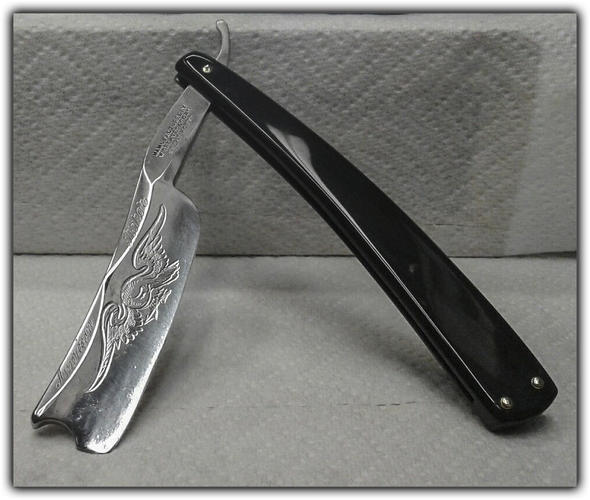Results 11 to 20 of 34
Thread: W. Greaves & Sons
-
11-12-2017, 05:34 PM #11

A restored Wm. Greaves & Sons with eagle etching and spine tooling. 15/16" width. Original horn scales replaced with black horn scales.
 Mark Polis, M.D., a.k.a., Mark
Mark Polis, M.D., a.k.a., Mark
He is the best physician who is the most ingenious inspirer of hope. - S. T. Coleridge
-
The Following User Says Thank You to JazzDoc For This Useful Post:
ejmolitor37 (11-20-2017)
-
11-12-2017, 11:53 PM #12Senior Member


- Join Date
- Aug 2014
- Location
- East Central Illinois
- Posts
- 782
Thanked: 101
I think this is a regrind from a near wedge because of that stub tail.
Slawman
-
11-13-2017, 03:05 AM #13
-
11-20-2017, 09:18 PM #14Senior Member


- Join Date
- Aug 2014
- Location
- East Central Illinois
- Posts
- 782
Thanked: 101
I take back what I said about a regrind.
-
11-20-2017, 09:28 PM #15
 Silverloaf
Silverloaf
-
11-20-2017, 09:59 PM #16
-
11-20-2017, 10:35 PM #17

Not sure I can teach anyone anything but here are a few thoughts. In my opinion the best place to start is looking at a LOT of razors, compare them in terms of what you most commonly see vs unusual findings for similar/dissimilar marked and/or shaped blades. read what others have said regarding those blades, shapes, grinds from the particular timeframe for each blade in question (Not everything written here is accurate and many times newer findings clarified earlier inaccuracies or misunderstandings so diligence is required when sifting through old posts here). I've been somewhat prone to jumping the gun myself and have inserted a foot or two into a wide open mouth

I personally Also look for obvious and blatant differences in surface texture, often regarding tangs and blade faces this can be more readily observed in person than in pics so I purchase an insane amount of blades just to examine sometimes. The level of Oxidation and the pattern it presents in are sometimes telling on more well executed regrinds. Traces of a blade etch under obvious grind lines are a dead giveaway.....
well, I guess after writing this far it will best to post pics for illustration purposes. I'll post a few pics later on.......Last edited by silverloaf; 11-20-2017 at 10:37 PM. Reason: misspelling
Silverloaf
-
11-20-2017, 10:47 PM #18
-
11-21-2017, 01:08 AM #19

read this thread:
http://straightrazorpalace.com/razor...revisited.html
Then some examples of what the op's Greaves may have looked akin to:
http://straightrazorpalace.com/razor...blade-now.html
http://straightrazorpalace.com/custo...lack-horn.htmlSilverloaf
-
11-21-2017, 01:23 AM #20

Regrinds have historical backing and can be beneficial in some cases but discretion again needs to applied here, since it certainly could erase some historical significance doing a regrind and details of a blades origin can be lost. Abating the spread of oxidation, evening up hone wear, making honing an easier task, correcting a fault in a blade. These have all been used as reasons for regrinding.
As seen in some of my pics here a regrind does not always mean hollow grinding a blade either. This is the far more attractive option to someone like me when a regrind is decided upon. If a blade is a near wedge when I commence a regrind it remains a near wedge when I've finished the regrind. As little surface metal removed as possible is my general rule.
p.s, the top pic shows some regrinds along with some hat are obviously hollow ground intentionally, and etched.Silverloaf


 15Likes
15Likes LinkBack URL
LinkBack URL About LinkBacks
About LinkBacks






 Reply With Quote
Reply With Quote
